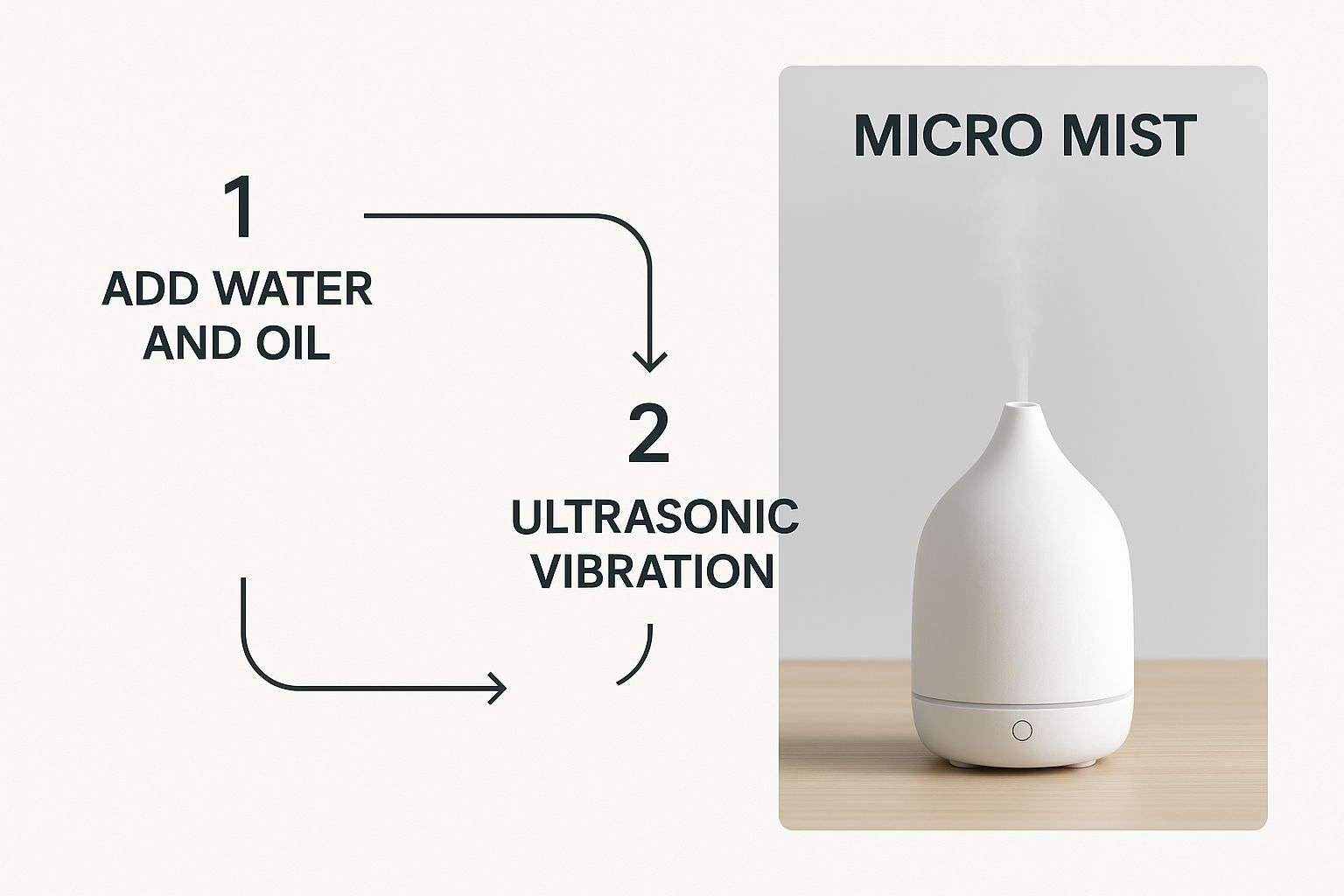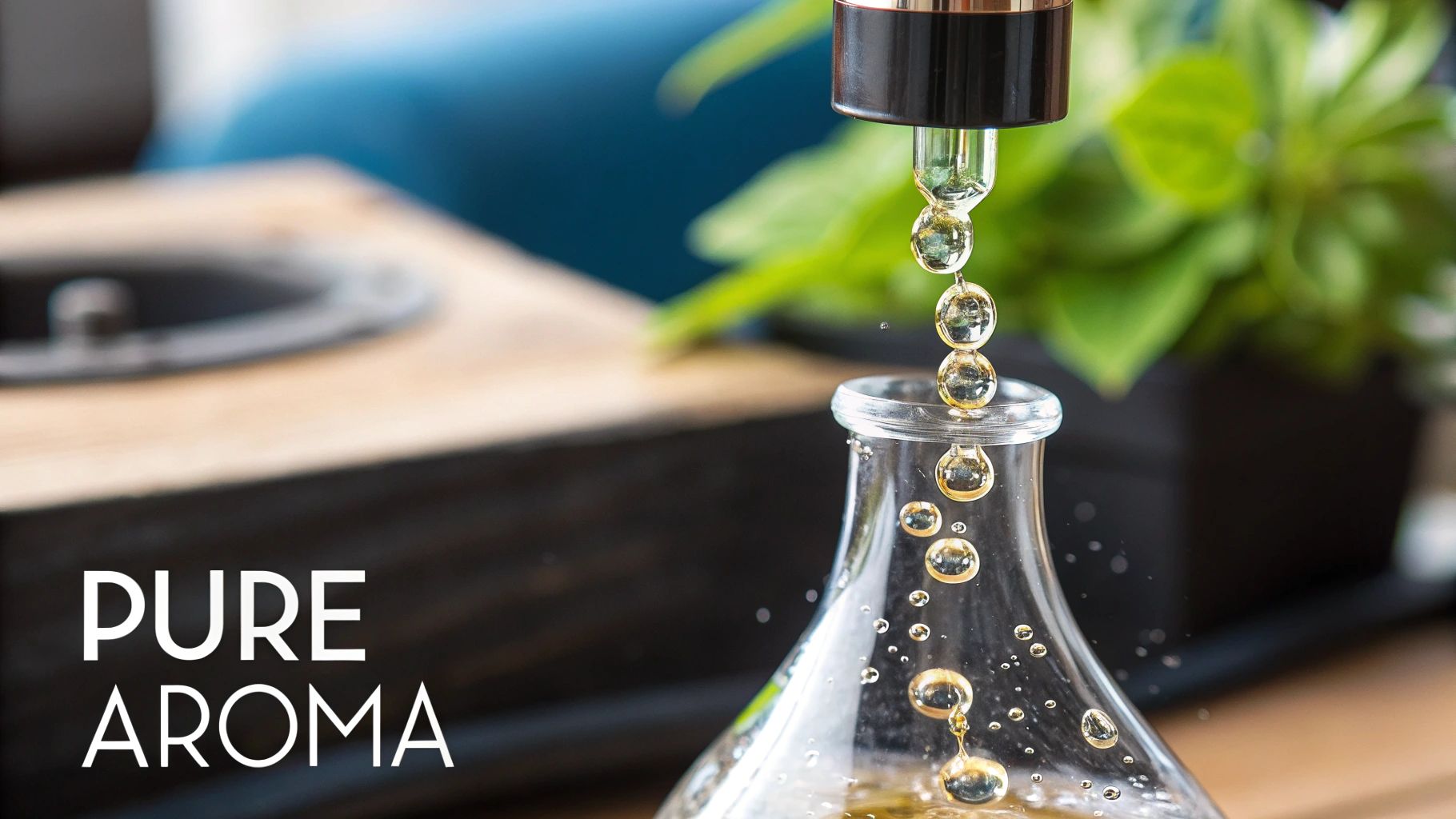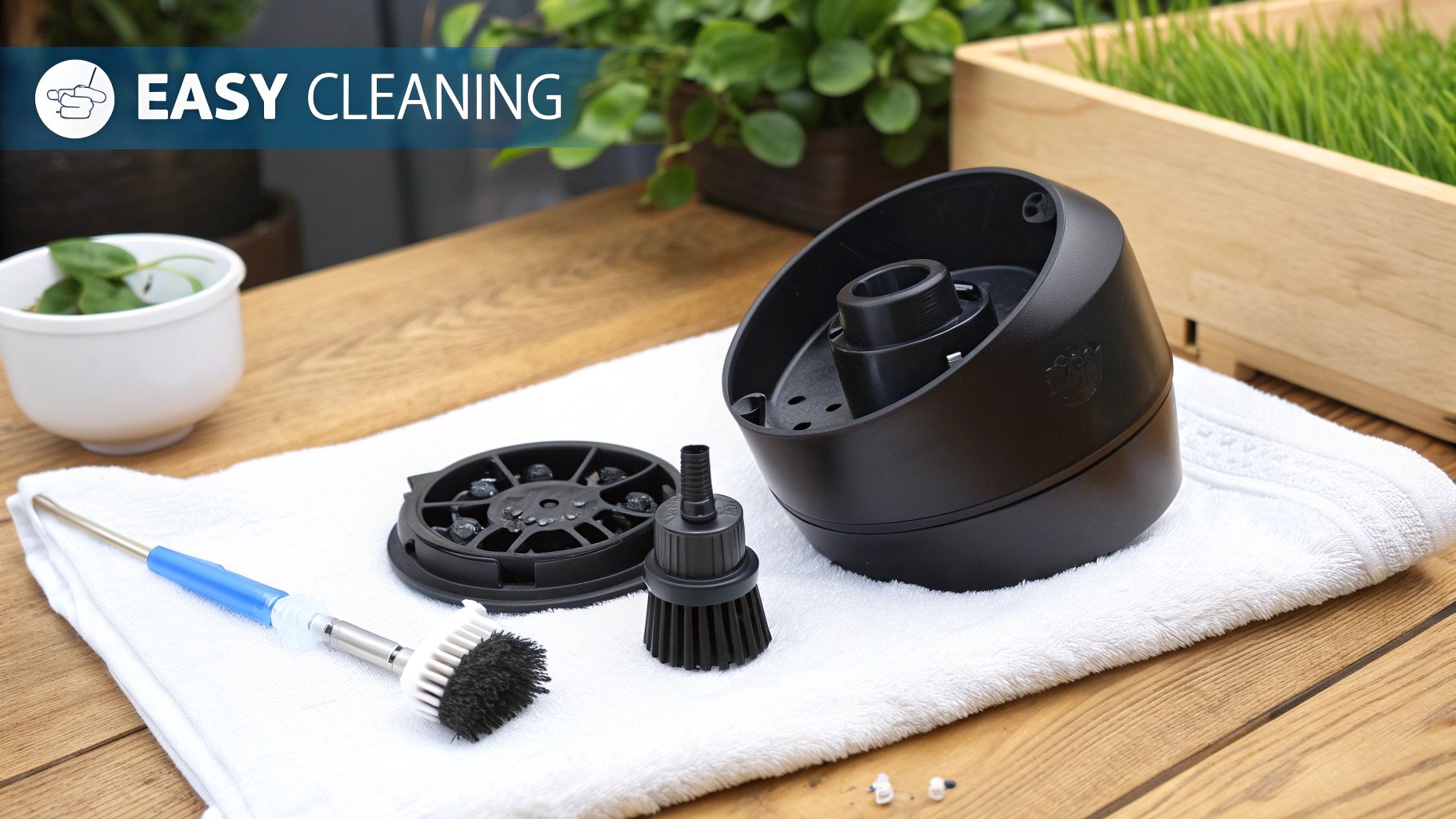How Does an Oil Diffuser Work? A Complete Guide
Jul 25, 2025
At its core, an oil diffuser is a pretty simple device: it breaks down fragrant oils into tiny, breathable particles and sends them floating through the air. The most common technology you'll see, ultrasonic diffusion, uses gentle vibrations to turn a mixture of water and oil into a fine, cool mist. This process fills your space with a luxurious scent without using any heat, which is key to preserving an oil's delicate and complex character.
The Simple Science Behind How Oil Diffusers Work
Ever wondered how a small, elegant device can completely transform the atmosphere of a room? The magic lies in turning a liquid fragrance into an airborne aroma. It’s the art of creating an immersive sensory experience—moving beyond just scenting a space to truly elevating it.
Most modern diffusers, especially ultrasonic models, work by using high-frequency vibrations to agitate a mix of water and essential oil. This agitation turns the liquid into an incredibly fine mist that carries both water and oil molecules into the air, allowing for a subtle and even distribution of scent. It's a surprisingly sophisticated market, and you can read the full research on aromatherapy diffusers to see just how much it has grown.
This heat-free mechanism is what really sets today's diffusers apart from older methods like candle warmers or basic evaporative sticks. Heat can actually change the chemical structure of delicate oils, degrading their quality. By contrast, ultrasonic technology preserves their integrity from the bottle to the air.
Key Takeaway: The main job of an oil diffuser is to atomize essential oils into a microscopic mist. Because this is a heat-free process, the aromatic and therapeutic qualities of the oils stay perfectly intact as they fill your environment.
Choosing Your Diffusion Method
While ultrasonic models are incredibly popular for their blend of efficiency and safety, they aren’t your only option. Getting to know the different technologies out there can help you pick the perfect device for what you want, whether that's intense scent payoff, therapeutic benefits, or just effortless ambiance.
To give you an at-a-glance summary, we’ve put together a quick comparison of the most common diffuser technologies. Each method offers a unique way to enjoy your favorite fragrances, from the potent, waterless diffusion of a nebulizer to the gentle, continuous scent of reeds. This will help you get a handle on the core differences before we dive into each one.
Quick Comparison of Popular Oil Diffuser Types
| Diffuser Type | How It Works | Scent Intensity | Best For |
|---|---|---|---|
| Ultrasonic | Uses electronic frequencies to vibrate water and oil into a fine, cool mist. | Adjustable (Low to Medium) | Everyday ambiance, humidifying dry spaces, and preserving delicate oil properties. |
| Nebulizing | Forces a stream of air across a small tube of oil, creating an atomized micro-mist without water. | High | Potent, pure aromatherapy sessions in large spaces where maximum scent is desired. |
| Heat | Gently warms the oil to encourage evaporation into the air. | Low to Medium | Simplicity and affordability, but heat can alter the chemical profile of some oils. |
| Evaporative/Reed | Wicks oil up through porous reeds or pads, allowing the scent to evaporate naturally into the room. | Low | Consistent, low-maintenance background fragrance in smaller, enclosed areas. |
Think of this table as your starting point. Now that you have a general idea of the landscape, you can make a more informed choice based on exactly how you want to experience fragrance in your home.
A Deeper Look at Ultrasonic Diffuser Technology
Of all the ways to scent a space, ultrasonic technology really hits the sweet spot between elegance and performance. Instead of heat, it uses high-frequency sound waves to create a beautifully fragrant mist. It’s a clever process that keeps the soul of your luxury fragrance oils perfectly intact.
The magic starts with a small, unassuming ceramic disc tucked inside. This little disc is the engine of the whole operation, vibrating at a frequency our ears can't even register—somewhere between 1.7 and 2.4 megahertz. The moment you switch the diffuser on, that disc starts humming at an incredible speed.
The Science of Vibration
Picture dropping a pebble into a glassy-smooth pond. You see the ripples spread out from the center, right? Now, imagine that happening millions of times every second. That's essentially what the ceramic disc is doing to the blend of water and essential oil in the diffuser's reservoir.
This constant, high-speed movement creates ultrasonic waves that pulse through the water. These intense vibrations are powerful enough to break the essential oils and water down into microscopic particles, forming a fine, cool mist. It’s a purely mechanical process, which means there’s zero heat involved—a critical detail for preserving the delicate aromatic compounds in high-quality oils.
The image below gives you a clear look at this journey, from the vibrating disc to the fragrant mist that fills your space.

This visual breaks down the key stages, showing how the micro-mist is created and then released, gently humidifying the air as it scents it.
Why a Heat-Free Process Matters
The lack of heat is probably the single biggest advantage of going ultrasonic. Most essential oils get their unique scent and character from volatile compounds. When you heat them up, these compounds can degrade or change completely, killing the quality and nuance of the aroma.
Because ultrasonic diffusion is a cold-air process, the integrity of the essential oil remains completely unchanged. You get to experience the fragrance exactly as the perfumer intended, with all its complex notes and subtle layers preserved.
This method ensures every single drop of a premium oil, like our "Dubai Gold" or "Rodeo Drive," is delivered in its purest form. The cool mist carries these tiny oil particles into the air, where they can linger for hours, creating a consistent and beautifully layered atmosphere.
The Dual Benefits of Scent and Humidity
Ultrasonic diffusers do more than just make a room smell amazing; they also offer a very practical benefit: gentle humidification. The fine mist adds a subtle touch of moisture back into the air, which can be a game-changer in dry climates or during winter when the central heating is blasting. This helps with a few common issues:
- Dry Skin and Lips: A little extra moisture in the air can help keep your skin feeling comfortable and hydrated.
- Sinus Irritation: Less dryness in the air can be soothing for your nasal passages.
- Static Electricity: Humid air naturally reduces that annoying static cling in carpets and fabrics.
This dual functionality makes an ultrasonic diffuser a seriously smart addition to any home, improving both the mood and the physical comfort of your space. If you're curious about portable scenting, learning how a battery-operated essential oil diffuser works shows just how versatile this technology has become.
Ultimately, this elegant process delivers more than just a pleasant scent—it creates a thoughtfully curated environment. When you understand how an oil diffuser works on this level, you can really appreciate the science and luxury working together to elevate your everyday life.
Comparing Alternative Diffuser Technologies
While ultrasonic technology hits that sweet spot of performance and preservation, it helps to understand the whole landscape. The world of home fragrance is surprisingly diverse, and knowing how an oil diffuser works across different methods gives you the full picture.
Exploring the alternatives really shines a light on why ultrasonic models are so often the go-to for daily luxury, but it also shows you where another type might be a better fit.
First up, let's talk about the powerhouse of the fragrance world—the nebulizing diffuser. This one is for the true scent purist.
Nebulizing Diffusers: The Scent Purist's Choice
A nebulizing diffuser works without a single drop of water. Picture a fine perfume atomizer, and you're on the right track. It uses a small, quiet air pump to shoot a high-speed stream of air across a tiny tube, pulling the essential oil up with it. This force is powerful enough to shatter the oil into a microscopic mist of pure, unadulterated aroma.
Because there’s no water or heat, the scent you get is incredibly concentrated and true to the original oil. This makes nebulizers the top choice for serious aromatherapy or for scenting very large, open spaces in a hurry. The trade-off? This intensity comes at a cost, as they go through oil much, much faster than other diffusers.

The image above gives you a sense of how varied these devices can be, from sleek, modern ultrasonic units to the simple elegance of a reed diffuser. Each one is designed for a different aesthetic and purpose.
Passive Diffusion: Gentle and Continuous Fragrance
On the complete opposite end of the spectrum are passive diffusers. These require no electricity at all. The most familiar example is the classic reed diffuser. You place porous reeds into a bottle of fragrance oil, and through a natural process called capillary action, the oil slowly wicks its way up the reeds. Once it reaches the top, it gently evaporates into the air.
This method is all about creating a constant, subtle background scent. It’s perfect for smaller spaces like a powder room or an entryway where you just want a low-maintenance, set-it-and-forget-it touch of fragrance. The payoff is low intensity, but the effect is effortlessly elegant.
Expert Insight: Passive diffusion is about consistency, not intensity. A reed diffuser won't fill your open-plan living room, but it excels at maintaining a delicate, welcoming scent in a defined area for weeks or even months on end.
Heat and Evaporative Diffusers: The Old Guard
Finally, it's worth touching on two older methods: heat and evaporative diffusers. You don't see them as much in the luxury market these days, but understanding how they work is helpful for comparison.
- Heat Diffusers: These use a small heating element—like a tiny hot plate—to warm the essential oil and cause it to evaporate. They’re simple and often cheap, but heat can actually change the chemical makeup of an essential oil, degrading its delicate notes and therapeutic qualities. They get the job done, but they don’t preserve the fragrance’s integrity.
- Evaporative Diffusers: This type uses a small fan to blow air over a pad or wick soaked in essential oil. The moving air speeds up evaporation and disperses the scent. The big drawback here is that the scent can come out skewed; lighter, more volatile aroma compounds fly off first, followed by the heavier ones, messing with the intended fragrance profile.
When you stack them all up, the balanced approach of ultrasonic technology really becomes clear. It delivers a noticeable yet controlled aroma, keeps the oil's quality pristine, and even adds a touch of beneficial humidity. It’s simply a fantastic all-around choice for creating a refined atmosphere in any modern home.
The Rise of Aromatherapy in Modern Homes
It’s hard to miss—oil diffusers have officially moved from a niche wellness item to a full-blown home essential. They’ve found a sweet spot right at the intersection of sophisticated decor, personal well-being, and smart technology. This isn't just about making our homes look good anymore; it’s about making them feel good.
And this isn't just a fleeting trend. The numbers tell a powerful story. The global market for aromatherapy diffusers, currently valued at around USD 1.5 billion, is exploding. Projections show it expanding at a compound annual growth rate of over 12.1% between 2025 and 2034, potentially soaring past USD 3.35 billion by 2032. This incredible momentum is all thanks to a growing understanding of just how much scent can shape our daily lives.
From Wellness Trend to Home Staple
So, what's fueling this incredible growth? It really comes down to a collective shift toward prioritizing self-care and mental health. Our homes have become our sanctuaries in a world that never seems to slow down. People are actively looking for simple, effective ways to dial down stress, get better sleep, or just create a more inviting atmosphere. An oil diffuser does all of that, and it does it beautifully.
The real magic is in the personalization. You can completely shift the mood of a room in seconds. One minute it's an energizing citrus to kickstart your morning, the next it's a calming lavender to help you unwind. That kind of control lets you tailor your space to exactly what you need, right when you need it.
The modern home is no longer just a physical space; it's an experience. Oil diffusers have become a key instrument in orchestrating that experience, using scent to build an emotional connection to our surroundings.
The Integration of Smart Technology
Another huge piece of the puzzle is the seamless integration of smart home tech. Today's diffusers are a world away from the simple plug-in models of the past. They’re packed with features that fit right into our connected lives, making the whole experience of aromatherapy easier and more customized than ever before.
We're talking about smart capabilities like:
- App-Based Controls: Tweak mist intensity, lighting, and schedules right from your phone, whether you're on the couch or on your way home.
- Custom Scheduling: Set your diffuser to greet you with an uplifting scent in the morning or to start winding down with a calming aroma in the evening—all automatically.
- Voice Assistant Compatibility: A simple "Hey Google, turn on the diffuser" is all it takes. It’s effortless control with voice assistants like Alexa or Google Assistant.
This blend of wellness and technology is what truly elevates the experience, turning a simple fragrance device into a sophisticated smart home staple. It's this powerful combination of style, real-world wellness benefits, and modern convenience that has secured its spot in today's homes.
Unlocking the Full Potential of Your Oil Diffuser
So, you’ve unboxed your new oil diffuser. Now what?
Knowing how the technology works is one thing, but really unlocking its power is another. It’s all in the little details—the setup, the daily use, and the simple upkeep. Master these, and your diffuser will become more than just a gadget; it’ll be a core part of your home’s ambiance and your daily wellness rituals.
Getting started is easy, but a little precision goes a long way. From the water you choose to the number of oil drops you add, these small tweaks make the difference between a nice scent and a truly transformative experience.
The Foundation: Your Water and Oil Ratio
First things first: water. You might be tempted to just use the tap, and while that works in a pinch, distilled water is always the better choice. Why? Because tap water is full of minerals that, over time, can build up on the diffuser's delicate ultrasonic plate. This scaling can weaken the mist and even shorten the life of your device. Using distilled water skips that problem entirely.
Next up is the magic ingredient—the oil. It’s so easy to go overboard here, thinking more oil means more scent. But that often just leads to an overwhelming aroma and wasted fragrance. There’s a sweet spot, and it’s surprisingly simple.
Rule of Thumb: A great starting point is 3-5 drops of essential oil for every 100ml of water. This concentration is just right for creating a noticeable, inviting scent that won’t overpower the room.
This ratio respects the delicate balance of the fragrance notes as they disperse. If you want a more intense burst of scent, you can always add an extra drop or two, but it’s best to start slow and build from there.
This quick video shows you just how simple it is to add your water and oil, setting the stage for a perfect diffusion session.
Following these simple steps ensures your device operates flawlessly, delivering that consistent, beautiful mist every single time.
Smart Placement for Optimal Scent Flow
Where you put your diffuser matters almost as much as what you put in it. Think of it like placing a speaker for the best sound—you want to find a central spot where the scent can travel. A side table, a bookshelf, or a console in the middle of the room is perfect. Just make sure it’s on a stable, flat surface where it’s safe from being knocked over.
Try to avoid placing it in direct sunlight, right next to an open window, or under an air vent. Any kind of draft can mess with the mist’s path, causing the fragrance to get lost or pool in one corner of the room. Give it some open space, and the fragrant mist will rise and circulate naturally.
Curating Your Atmosphere
This is where the real fun begins. One of the best parts of owning a diffuser is playing scent-curator for your own life. You can completely change the mood of a room to match the time of day, how you’re feeling, or the vibe you want to create.
- For an Energizing Morning: Kickstart your day with bright, zesty citrus oils. A few drops of lemon and grapefruit can sharpen your focus and give you a natural mood lift.
- For a Calm Evening: As the day winds down, switch to the soothing notes of lavender and chamomile. These classic scents are famous for helping you relax and drift off into a peaceful sleep.
Don’t be afraid to experiment with different combinations and single oils to see what you love. If you need some inspiration, we have a guide to the 7 best essential oils for home scent that’s full of great ideas.
It’s clear these devices are becoming a staple in modern homes. Market data shows a huge shift in consumer habits, with diffusers becoming a leading category in home care. While you can find them everywhere from hypermarkets to supermarkets, the real growth is happening online. Younger buyers, who care deeply about ingredient transparency and smart features, are flocking to e-commerce. Discover more insights about these diffuser market statistics on freeyourself.com.
The final piece of the puzzle? Regular cleaning. It sounds like a chore, but it’s the secret to getting the most out of your diffuser long-term.
Weekly Diffuser Maintenance Checklist
A quick, simple cleaning routine is all it takes to keep your diffuser running like new. This prevents oil buildup and mineral scaling, ensuring every scent experience is as pure and powerful as the first.
| Step | Action | Frequency |
|---|---|---|
| 1. Unplug & Empty | Safely unplug the device and pour out any remaining water. | Weekly |
| 2. Wipe Clean | Use a soft cloth or cotton swab dipped in rubbing alcohol to gently wipe the inside of the reservoir, especially the ultrasonic plate. | Weekly |
| 3. Rinse & Dry | Rinse the reservoir with clean water (avoid getting water in the electronic parts) and wipe it dry with a clean cloth. | Weekly |
| 4. Deep Clean (Optional) | For a deeper clean, fill the reservoir halfway with water and add a few drops of white vinegar. Run for 5-10 minutes, then empty and rinse. | Monthly |
This small commitment protects your investment and guarantees you get that flawless, fragrant mist you love, year after year.
Common Questions About Oil Diffusers
Even once you get the hang of how your oil diffuser works, a few practical questions almost always pop up. Getting straight, simple answers helps you use your device with confidence, making sure you’re creating the perfect atmosphere without any simple slip-ups.
Let's dive into some of the most common questions we hear about daily use, safety, and keeping your diffuser in top shape.
Can I Leave My Oil Diffuser On All Night?
While it’s tempting to let that calming scent run for hours, it's generally best to use your diffuser intermittently, not for eight straight hours. Most high-quality diffusers come with a handy auto-shutoff feature, which is a great safety net for when the water runs out.
But here’s the real reason to give it a rest: running it for shorter bursts of 30-60 minutes is actually more effective. Constant exposure can lead to what’s called olfactory fatigue—a fancy term for your nose getting used to the scent and simply tuning it out. Using a built-in timer is the perfect way to enjoy those calming benefits for sleep without overdoing it.
What Is the Difference Between a Diffuser and a Humidifier?
This is a classic point of confusion, but the answer is pretty simple. An oil diffuser’s main job is aromatherapy—dispersing beautiful essential oil fragrances into the air. A humidifier, on the other hand, is all about adding a significant amount of moisture to the air to fight dryness.
Sure, an ultrasonic diffuser releases a fine, cool mist that adds a tiny bit of humidity, but it’s a secondary benefit and not nearly enough to humidify a whole room.
Crucial Distinction: Never, ever put essential oils into a standard humidifier. The oils are corrosive and can eat away at the plastic, ruining the internal parts which just aren't built to handle them. Diffusers are specifically designed for this purpose.
The image below is a perfect example of how a diffuser can elevate a room, adding both style and a welcoming ambiance.

This setup shows just how seamlessly a sleek diffuser can blend into your decor while actively enhancing the feel of the space.
How Often Should I Clean My Diffuser?
Want your diffuser to last and perform beautifully? Regular cleaning is the secret. For peak performance, you should give it a quick rinse and wipe-down after every few uses. This simple step prevents different oil scents from mingling and becoming muddled.
A deeper clean should be part of your routine about once a week. This isn't complicated—just use a bit of white vinegar or rubbing alcohol on a cotton swab to gently clean the ultrasonic plate. This dissolves any stubborn oil buildup, keeping your mist strong and your fragrances pure and true.
Can I Use Any Kind of Oil in My Diffuser?
This is a big one, and the answer is a hard no. You should only ever use 100% pure, high-quality essential oils.
Synthetic fragrance oils, perfume oils, and other cheap alternatives often contain carrier oils, alcohol, or other chemicals that aren't meant to be turned into a mist and inhaled. These substances can clog the delicate ultrasonic mechanism, permanently break your diffuser, and might not be safe for your respiratory system. Always stick with pure essential oils from a brand you trust—it protects both your health and your investment.
Ready to transform your space with sophisticated, hotel-inspired aromas? Explore the full collection of luxury fragrance solutions from Airomatica.



